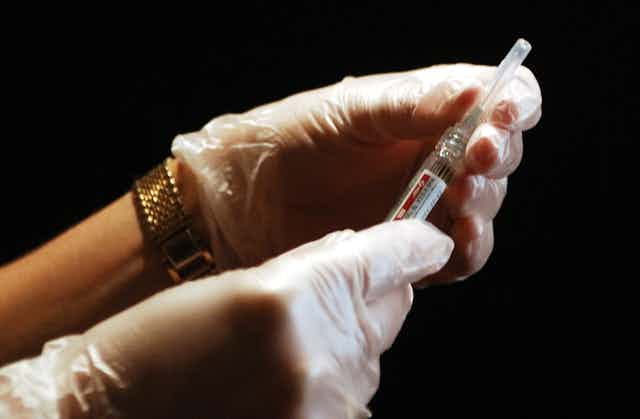The human papillomavirus (HPV), which causes cervical cancer in women, is also responsible for many cancers in men. It causes most cancers of the tonsils (known as oropharyngeal cancers), which are more common in men than women. HPV is also to blame for cancers of the anus, vulva, vagina and penis.
Oral cancers – which include those of the tonsils, mouth and tongue – affect more than 300,000 people globally each year. A person living in Australia has a one in 49 estimated risk of being diagnosed with head and neck cancer by their 85th birthday, which includes oral cancers.
The chance is higher in males (one in 32) than females (one in 98). An estimated 769 males will die from head and neck cancer in Australia in 2016, compared to 247 females.
The best way to prevent these cancers is to get the HPV vaccine, which is available for free under Australia’s National HPV Vaccination Program to boys and girls aged 12 and 13. Those over 14 can obtain the vaccine from their GP or local immunisation provider, but they will need to pay for it.
What is the human papillomavirus (HPV)?
Most of us (around 80%) will acquire an infection from a virus in the human papillomavirus family at some point in our lives – usually without knowing it, as there are often no symptoms. HPV infections are transmitted through vaginal and oral sex, and even kissing.
HPV is a group of viruses first identified in the mid-1970s. There are now more than 170 known types, which can infect the skin and live in the genital tract and on the lining inside our mouth.
When they live on your skin, they manifest into the common wart. The viral culprits responsible are usually the “low risk” HPV types: 6, 11, 13 and 32.
But when the virus invades the lining of the mouth, throat, respiratory tract and genitals, the infection can lead to cancer. Long-term infection with “high risk” HPV types such as 16, 18, 31, 33, 45, 52 and 58 are major risk factors for cervical cancer, cancer of the anus, genitals and oropharyngeal cancers.
The oropharynx is the middle part of the throat which includes the base of the tongue, tonsils, the soft palate and the walls of the pharynx.

A recent study showed HPV was present in 91% of cervical and anal cancers, 75% of vaginal cancers, 69% of vulvar cancers, 63% of penile cancers and 70% of oropharyngeal cancers.
HPV 16 is the main virus responsible for mouth infections; and both men and women are equally affected by the virus.
There is no medical treatment for the virus itself but the body will often clear the virus, usually within two years of detection. However, the virus can live in some people for years, with visible symptoms only appearing ten to 20 years after the first infection.
When the virus causes oropharyngeal cancer, patients with early-stage tumours are treated with radiation therapy or the tumour is removed surgically. These patients have a 90% survival rate past five years and most live a normal life.
Unfortunately, most patients will present with late-stage disease where the five-year survival rate is 40%. The grim prognosis for patients with advanced oropharyngeal cancer has not changed in the last decade despite vast improvements in treatment techniques.
While the population incidence of oropharyngeal cancer is relatively low, it is rising exponentially. In the United States, the incidence of HPV 16-positive oropharyngeal cancers has increased by 225% between 1988 to 2004 (from 0.8 per 100,000 people to 2.6 per 100,000).
If these trends were to continue, the annual number of HPV 16 positive oropharyngeal cancers would surpass the annual incidence of cervical cancers (currently 7.5 per 100,000 people) by the year 2020.
The HPV vaccine
The HPV vaccine was developed by Australian scientists in 2006 to protect women from cervical cancer. In 2007, Australia was one of the first countries to implement a secondary high school HPV vaccination program for girls, which was then extended to include boys in 2013.

Although initially intended as a preventative vaccine against cervical, anal and genital cancers, the vaccine can also protect men and women from oropharyngeal cancers. The two HPV vaccines available in Australia (Cervarix and Gardasil) are licensed for males aged nine to 26 and females aged nine to 45.
A decade has now passed since the initial administration of HPV vaccines in certain countries to pre-adolescent girls. As of January 2016, one of the four branded vaccines, Gardasil, has been administered in more than 200 million doses worldwide.
In Australia and the United States, infections with HPV types 6, 11, 18 and 16 have reduced by 87%. There was a 85% reduction in high-grade cervical abnormalities in Australia, Europe, North America, and New Zealand.
The impact of the vaccine in preventing mouth cancer can’t yet be accurately assessed, as the average age of disease is 56 years, and the girls vaccinated haven’t yet reached that age. However, the reduction in HPV infections worldwide due to the vaccine would suggest a future decrease in all HPV associated cancers.
In Australia, 83% of girls aged 15 were vaccinated with HPV in 2015, compared to 70% of males. Only 55% of females between 18 and 24 years were vaccinated. These figures suggest that between 20% to 30% of young males and females are not protected against HPV infection.
Modern medicine has delivered the opportunity to prevent HPV-related cancers. If international health organisations can implement a global immunisation program to high-, middle- and low-income countries, these cancers will become rare events and no longer pose a threat for future generations.
*Since publication, Samantha Khoury has been added as a co-author.

